40+ Employee Recognition Statistics Show Why It's So Important in 2025

If you're reading this, you likely have at least heard of employee recognition. You may even know how powerful it can be for things like employee engagement, organizational culture, and employee retention – whether from reading about it or experiencing it in your own career.
You may have also heard that in the modern workplace, employee recognition isn't just a nice-to-have, it's a necessity.
So, we know recognition can be a powerful tool, but just how powerful? Could you quantify it? If the answer is no, don't worry. We recently partnered with Gallup to do just that.
Using data from thousands of employees across the U.S. and Western Europe, this Gallup report brings to light essential insights on what good recognition looks like, according to the people giving and receiving it.
Below we'll break down why recognition is important in today's workplace and provide you with the most up-to-date employee recognition statistics that leaders and HR professionals need to be aware of in the future of work.
40 employee recognition statistics that proves it's important in 2025
In today's world, information is coming at us from every direction imaginable. But occasionally you come across a piece of data so impactful, it sticks with you.
Here are 40 statistics around the impact employee recognition (or lack thereof) can have on your organization, signifying why it's so important in today's work environment.
| Category: Performance | Statistic |
|---|---|
| Download report | Best-in-Class companies are 41% more likely than All Others (65% vs. 46%) to empower employees to recognize each other for great work, or what is called peer-to-peer (P2P) recognition. |
| Download reportOpens in a new tab | More than 92% of people would trust their senior leader more if they were more transparent about their mistakes, and 85% of people believe a high-trust work environment helps them perform at their best. |
| Download report | For one of Workhuman's customers, employees who received 5+ awards were nearly 2x as likely to improve their year-over-year performance. |
| Download report | Only 26% of employees strongly agree they receive similar amounts of recognition as other team members at their company with similar performance levels |
| Download report | Recognition drives a 32% increase in employee performance when combined with feedback and incentives. |
| Download report | Employees who receive authentic recognition are 5x as likely to strongly agree they see a path to grow at their organization. |
| Download report | (Figure 1 below) Each moment of recognition contributes to a greater likelihood of high performance, and that holds true whether the employee was previously a high performer or not – high performers are simply starting from a higher base probability. These findings are summarized in Figure 1 below. |
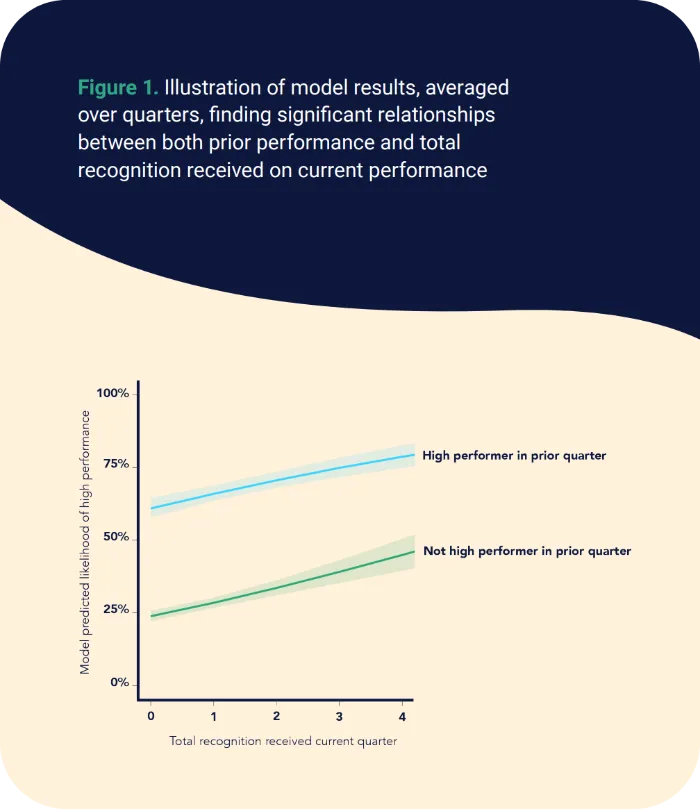
| Engagement | Statistic |
|---|---|
| Download report | Employees who feel undervalued in the workplace are 5x as likely to be disengaged. |
| Download report | When recognition is consistently fulfilling, authentic, equitable, embedded, and personalized, employees are 4x as likely to be engaged. |
| Download report | Employees who’ve had conversations with their managers about goals, progress, and wins in the last six months are 2.8x more likely to be engaged. |
| Download report | At one global biopharmaceutical company, recognition was found to be 8x more powerful than salary increases in improving engagement. |
| Download report | Workhuman and SHRM research found that 84% of companies surveyed said social recognition measurably and positively impacted employee engagement. |
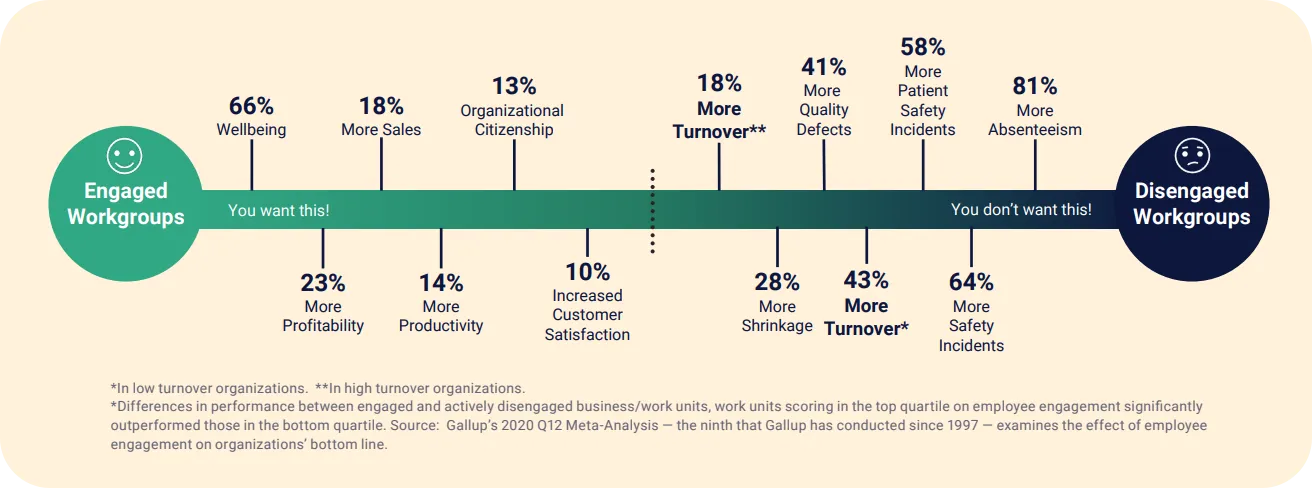
| ROI | Statistic |
|---|---|
| Download report | Customers that invest 10% more per employee in a recognition program show an average high productivity of $3,900 per employee. For a 15,000-person organization, this equates to an annual benefit of $58 million compared to industry peers. |
| Download report | Compared to the bottom quartile, companies in the top quartile for engagement experience 23% higher profitability. |
| Download report | Each $1 invested in strategic employee recognition can generate $5-7 in return. |
| Download report | An engaged culture can save a 10,000-person organization more than $16 million annually through recognition efforts. |
| Download reportOpens in a new tab | Recognition viewed as an investment can create nearly $215 million of value or a 6.9x ROI. |
| Retention | |
|---|---|
| Download report | 68% of employees plan to stay at their organization for five years or more when their recognition needs are fulfilled. |
| Download report | 74% of employees are more likely to say they don’t plan to be at their company in one year if they feel undervalued at work. |
| Download report | For every 10 percentage point increase in recognition, jetBlue saw a 3 percentage point increase in retention, as well as 2 percentage point increase in engagement. |
| Download report | Turnover drops from 18% to 11% when employees receive recognition versus none, and down to 7% for employees receiving and giving recognition (businesses paid at least $2.37 trillion on turnover in 2021 alone). |
| Download report | For one leading pharmaceutical company, frequent recognition correlated with 15% lower turnover. |
| Download report | New hires receiving recognition are 5x less likely to leave within the first year. |
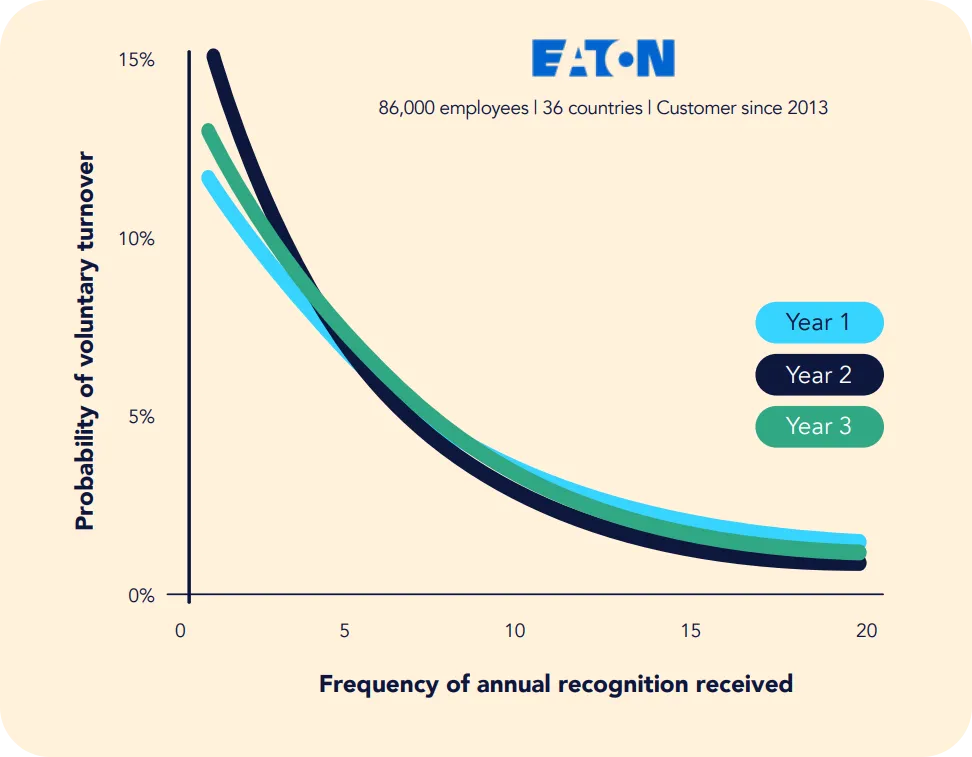
| Wellbeing | Statistic |
|---|---|
| Download report | Employees who don't feel valued at work are 27% more likely to be struggling in their life overall. |
| Download report | When employees receive the right recognition at work, they are 73% less likely to "always" or "very often" feel burned out. |
| Download report | When an employer recognizes life events and work milestones, employees are 3x as likely to strongly agree their organization cares about their wellbeing. |
| Download report | When strategic recognition is implemented, Employees are twice as likely to have a positive outlook on their lives and future. |
| Download report | Employees who receive recognition are 44% more likely to be thriving in their lives overall. |
| Employee Experience | Statistic |
|---|---|
| Download report | When recognition is consistently fulfilling, authentic, equitable, embedded, and personalized, employees are 5x as likely to feel connected to company culture. |
| Download report | Only 10% of employees report being asked about their preferences for receiving recognition. |
| Download report | Recognition directly impacts motivation for 31% of employees. |
| Download report | Employees who lack a strong sense of belonging are up to 12x as likely to be disengaged and 5x as likely to be looking for another job. |
| Download report | Employees who have good recognition experiences are 3x more likely to strongly agree they feel a sense of loyalty to their organization. |
| Download report | When remote employees feel they’re getting the “right amount” of recognition, they’re 3x more likely to feel strongly connected to their organization’s culture. |
| Leadership & Management | Statistic |
|---|---|
| Download report | 81% of leaders say recognition is not a major strategic priority for their organization. |
| Download report | 73% of senior leaders say their organization does not offer managers or leaders best-practices training for employee recognition. |
| Download report | Only 23% of employees strongly agree their organization has a system in place to recognize work milestones. |
| Download report | 36% of employees say their organization has a recognition program. |
| Download report | 40% of employees say they receive recognition from a manager, supervisor, or other leader a few times a year or less. |
| Download report | Employees who receive recognition from their manager at least a few times a month are more than 3x as likely to be engaged than those who receive it less often. |

Does an employee recognition program really improve employee engagement and motivation?
Employee recognition programs can have a hugely positive impact on employee engagement and employee motivation. But remember, these employee recognition statistics are only possible if recognition is done right.
Here we'll go over some of the most important aspects to keep in mind when building out a successful employee recognition program.
What types of recognition do employees value most?
Employee recognition isn't just remembering to say "thank you," nor are all kinds of recognition the same.
On a broad scale, recognition can be divided into two subsets: top-down recognition coming from a manager, leader, or other supervisor, and peer-to-peer recognition coming from anyone up and down the organizational structure.
According to Gallup, those employees who receive recognition only a few times a year from leaders are:
- 5x as likely to be actively disengaged
- 74% more likely to say they do not plan to be at the organization in one year
- 27% more likely to be struggling
Those employees who receive recognition only a few times a year from peers are:
- 3x as likely to be disengaged
- 39% more likely to say they don't plan to be at the organization in one year
- 24% more likely to be struggling
The data above shows neither type of recognition is truly "hitting the mark." Even though employees receiving recognition from peers are less likely to be disengaged than those who only receive recognition from leaders, the numbers still don't look great. Why is that?
In order for employee recognition to be both valued by employees and valuable for organizations, recognizing employees must be done in a frequent and consistent manner.
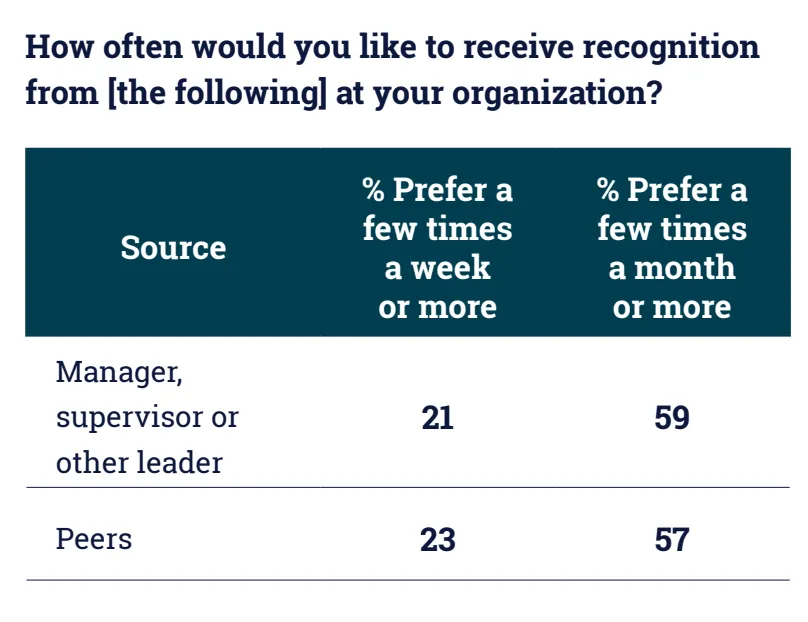
The data also shows the significantly higher impact of peer-to-peer recognition programs rather than only allowing senior leaders or HR professionals to give recognition.
If there is one thing to take away from this data, it's that a few times a year is not enough to move the needle on employee engagement, employee turnover, and employee satisfaction.
What makes recognition memorable?
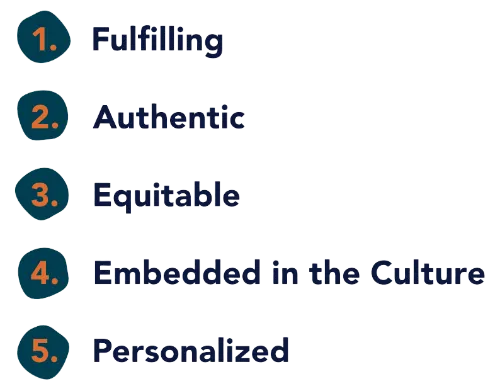
A truly meaningful recognition moment can stick with an employee for their whole career. But what does "truly meaningful" really mean? And how can organizations provide managers the skills and resources to make these memorable moments happen?
According to Gallup's findings, memorable recognition that hits the mark must be:
- Fulfilling: Recognition moments must be genuine and create a consistent, reliable experience.
- Authentic: Awards must mean something, both to the giver and the receiver.
- Equitable: While every award message should be unique, employees should be recognized in a consistent, equitable way - especially with monetary rewards.
- Embedded in the culture: Recognition must be weaved into employees' everyday life in order to build a genuine culture of appreciation.
- Personalized: Different employees have different preferences on how or where they receive employee recognition.
These five pillars are essential for organizations looking to create the most memorable recognition for their employees.

Critical employee recognition research findings
Now that we've quantified just how powerful an employee recognition program can be, it's time to take a look at how these programs are performing in the real world.
What percentage of companies have recognition programs?
Gallup's research report found that only 36% of employees report their organization having some sort of recognition system in place.
Further, only 21% of employees report their organization tying monetary rewards to their recognition strategy.
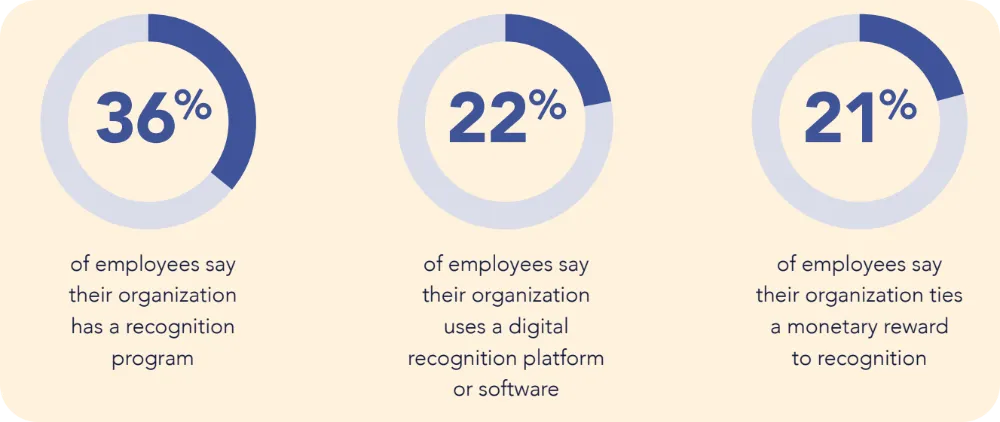
This is especially surprising considering Workhuman® research found recognition with monetary rewards are 20% more effective than e-thanks alone when looking at reducing turnover.
By investing in recognition, you can save even more on reducing turnover - along with the myriad of other recognition benefits we've discussed.
How often should employees be recognized?
One of the five pillars of good recognition is personalization - because each employee has a different idea of what the most meaningful recognition looks like to them.
Even so, Gallup research found only 10% of employees report being asked about their preferences for how and how often they get recognition.
Unfortunately, most companies are falling short on both the way recognition is given and how often. The new report found only 23% of employees strongly agree they get the right amount of recognition for the work they do. Something doesn't seem right.

How effective are employee recognition programs?
When done right, a successful employee recognition program can be the most effective tool in your organization's toolkit. And if the employee recognition statistics above weren't enough to prove its efficacy, this certainly will.
By creating a strong culture focused on rewarding employees for their good work, organizations can save millions.

In fact, a 10,000 person company can save up to $16.1 million in turnover costs annually. That's not even including the cost savings from increased engagement or productivity!
The 36% of organizations that have an employee recognition program also have a huge leg up against their competition.
And until that statistic hits 100%, it will continue to be difficult to make employees feel appreciated, potentially wreaking havoc on employee turnover, employee satisfaction, employee performance, and so much more.
Conclusion
The data and insights discussed underscore the profound impact that strategic recognition programs can have on employee engagement, motivation, and organizational culture.
From reducing turnover and enhancing productivity to fostering a sense of belonging and wellbeing, the benefits of recognition extend far beyond the immediate moments of acknowledgement. Organizations that prioritize and effectively implement these programs not only enhance their workplace atmosphere but also drive significant business results.
As we look forward towards the future of work, integrating meaningful recognition into the fabric of corporate culture is not just beneficial; it's essential for attracting, retaining, and maximizing the potential of every employee.
About the author
Sarah Bloznalis
Sarah Bloznalis is a content marketing specialist at Workhuman from Dorchester, Mass.